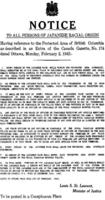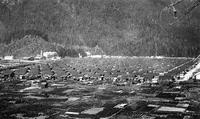Japanese, Relocation of
JAPANESE, RELOCATION OF, was the forced removal of people of JAPANESE descent from coastal BC during WWII. The Japanese attack on Pearl Harbor on 7 Dec 1941 raised the question of an invasion of the Pacific coast of Canada. The authorities saw all people of Japanese descent in BC—whether or not they were Canadian-born citizens, naturalized Canadians or citizens of Japan—as a possible fifth column sympathetic to the enemy. As a first step the government closed Japanese-language newspapers and impounded FISHING vessels belonging to Japanese fishers. Then, on 14 Jan 1942, the federal government passed Order-in-Council PC365 creating a 160-km-wide "protected area" along the coast. All Japanese nationals aged 18–45 were removed to work camps near Jasper, AB. Late in Feb another Order-in-Council authorized the removal of all persons "of the Japanese race," whether they were Canadians or not, from the coastal zone. It also imposed a dusk-to-dawn curfew on Japanese and allowed police to search premises and remove belongings without warrant. On 4 Mar 1942 a BC Security Commission was established to supervise the relocation of the people removed from the coast. Chaired by Austin TAYLOR, a Vancouver financier, it included RCMP Assistant Commissioner Frederick Mead and BC PROVINCIAL POLICE Assistant Commissioner John Shirras. A Custodian of Enemy Property was named to manage property belonging to the evacuees. People of Japanese ancestry living in the zone were required to congregate at Hastings Park in east VANCOUVER. The majority were sent to communities in the BC Interior selected as relocation centres: GREENWOOD, SLOCAN, SANDON, KASLO and NEW DENVER. Settlements at ROSEBERY, Bay Farm, Popoff, Lemon Creek and TASHME consisted mainly of buildings constructed specifically for the purpose. Other people were sent to work on sugar beet farms in Alberta, Manitoba and Ontario. Men who refused to be relocated, in protest at being separated from their families, were interned in prisoner-of-war camps in Ontario until the Security Commission relented and arranged for family reunification. A total of nearly 22,000 people were relocated by Nov 1942. Early in 1943 the Custodian of Enemy Property was authorized to sell off property belonging to the internees. This was done ostensibly to pay for the cost of their relocation; in other words, they were required to pay for their own involuntary removal. In the spring of 1945, as the war wound to its conclusion, the federal government offered internees a choice between deportation to Japan and permanent relocation to provinces east of the Rockies. In the end, deportation was cancelled in the face of public protest, though not before 3,964 people were sent to Japan. Relocation went ahead, however, and the BC camps emptied as internees were uprooted a second time and moved across the mountains, mainly to Ontario, which by 1947 had as large a population of Japanese Canadians as BC. At war's end there were 6,776 Japanese Canadians living in BC, down from a pre-war population of about 22,000. Not until 1949 were people of Japanese ancestry allowed to return to live on the BC coast.
In 1947, in response to demands from the Japanese Canadian community for compensation for the property seized during the war, the federal government established the Royal Commission to Investigate Complaints of Canadian Citizens of Japanese Origin, known as the Bird Commission after its chair, BC justice Henry Irving Bird. The commission was mandated only to investigate economic losses from the wartime sale of property by the Custodian. Bird's 1950 report resulted in payments totalling $1.2 million to individuals who had submitted claims. From the government's point of view this closed the book on the relocation, but the Japanese Canadian community did not forget. In 1984 the National Association of Japanese Canadians launched a campaign seeking redress for the events of the war. On 22 Sept 1988, following protracted negotiations, the federal government formally apologized for "past injustices" and offered a compensation package including a payment of $21,000 to every evacuee still living, $12 million to the Japanese Canadian community and $24 million to create a national race relations foundation.
Historians differ in their explanations for the relocation. At the time the government insisted it was motivated by security concerns, though senior military and police officials advised that the relocation was unnecessary. No Japanese Canadian was ever charged with disloyalty. The most widely held interpretation of events is that racist politicians in BC used the war as an excuse to attempt to remove the province's Japanese population permanently. A minority view takes more seriously the state of panic that prevailed at the time and argues that the government, however mistakenly, was motivated by a desire to protect the evacuees from British Columbians made suspicious and vengeful by the war. According to this view, authorities worried that if Japanese in Canada were harmed, the government of Japan might retaliate against Canadian prisoners-of-war in that country. Whatever the government's motivation, the relocation is now recognized to have been a deplorable violation of HUMAN RIGHTS, one of the worst in BC's history. Reading: Roy Miki, Redress: Inside the Japanese Canadian Call for Justice, 2004.


